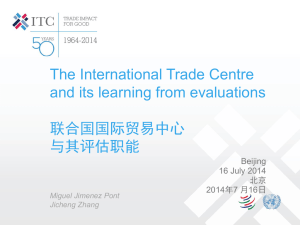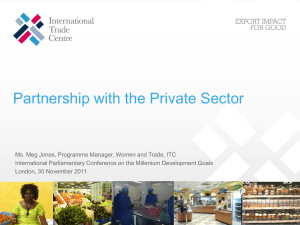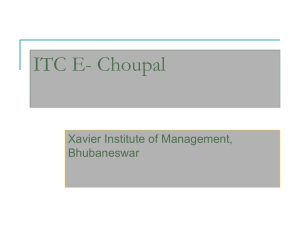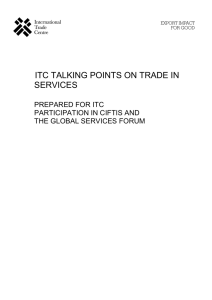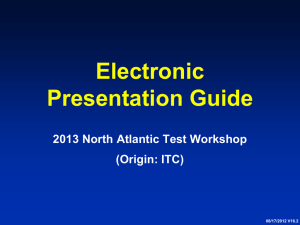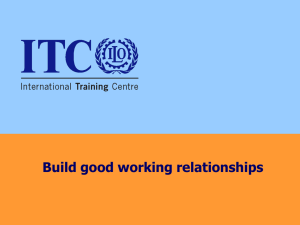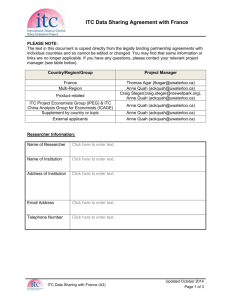ITC: Export Impact for Good - Second United Nations Conference on
advertisement
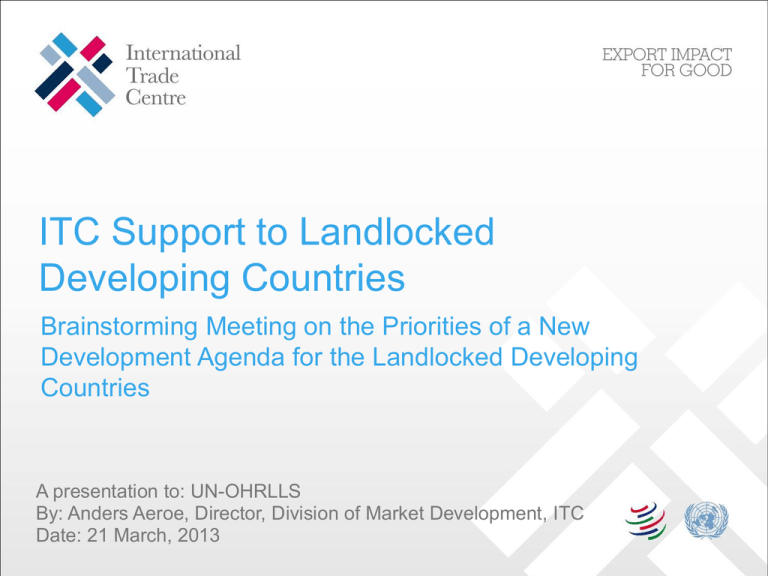
ITC Support to Landlocked Developing Countries Brainstorming Meeting on the Priorities of a New Development Agenda for the Landlocked Developing Countries A presentation to: UN-OHRLLS By: Anders Aeroe, Director, Division of Market Development, ITC Date: 21 March, 2013 2 ITC Mandate “ The role and support of the private sector are essential if we are to be successful. It is in this spirit that I have held in-depth consultations with Ms Patricia Francis of ITC on how to elaborate a global strategy aimed at enhancing the role of the private sector, particularly in developing countries. ” Pascal Lamy (2nd Global Aid for Trade Review) • To enable export success for small and medium-sized enterprises (SMEs) • Pro-poor agenda – emphasis on Africa and LDCs, LLDCs and SIDS. • Contribution to MDGs – especially: – 1: Eradicate Extreme Poverty and Hunger – 3: Promote Gender Equality and Empower Women – 7: Ensure Environmental Sustainability – 8: Global Partnership for Development 3 ITC’s Areas of Work 4 Trade Intelligence ITC builds capacities in trade information services, in market research and analysis and the formulation and implementation of export strategies. Example: ITC supported the Central African Republic in conducting a customized export potential assessment. This allowed policy makers and TSIs to identify products and sectors with high export potential which contributed to the formulation of a National Export Strategy. Enhancing trade support institutions and policies ITC builds capacities of Trade Support Institutions to support the private sector. ITC also works on building stakeholder confidence in developing appropriate policy and regulatory reform processes. Example: ITC supported Lao PDR in preparation for WTO accession, by strengthening stakeholder confidence in the government's bid for membership. 5 Strengthening export capacity of enterprises ITC assists small and medium sized enterprises in building productive capacities and reach global markets. Example: ITC's Trade Promotion Project in Tajikistan strengthens the sustainable expansion and diversification of SME exports from Tajikistan. Inclusiveness and sustainability ITC mainstreams inclusiveness and sustainability into trade promotion and export development policies Example: ITC works to enhance the capacity of Ugandan women informal cross-border traders (ICBTs) to increase their exports to neighbouring countries by reducing and eliminating trade facilitation impediments at points of entry and exit. 6 ITC’s projects in LLDCs 2010-2013 Afghanistan, Armenia, Bhutan, Bolivia, Botswana, Burkina Faso, Burundi, Central African Republic, Chad, Ethiopia, Kazakhstan, Kyrgyzstan, Lao PDR, Lesotho, Republic of Macedonia, Malawi, Mali, Nepal, Niger, Paraguay, Rwanda, Swaziland, Tajikistan, Uganda, Uzbekistan, Zambia, Zimbabwe (27 in total) 7 LLDCs Exports 2001- 2011 Percentage change in export 2001-2011 Note: Includes all export groups (oil as well as services) 8 Export by level of processing raw materials semi-processed goods processed goods 2007 2011 2007 2011 2007 2011 LLDCs 32.7% 37.2% 47.9% 46.8% 19.5% 16.0% Developing 8.4% 10.7% 20.6% 21.6% 71.0% 67.7% LDCs 31.2% 29.9% 27.2% 28.4% 41.6% 41.8% Note: Export values are US$ billion. Percentages show the share of each product group in total exports by country group. Excluding oil. 11 The ITC Programme on NTMs • Business perspective in focus • Direct empirical research through company level surveys • In-depth analysis of survey results as diagnostic of the current situation of companies with regards to NTMs • Carried out in close collaboration with national and international partners • Around 30 beneficiary countries between 2010 and 2013 The ITC Programme on NTMs - Survey countries As of 1 January 2013 9,339 phone interviews 3,290 face-to-face interviews (plus 7 pilot countries) What are Non-Tariff Measures (NTMs)? • Official policy measures on export and import, other than ordinary customs tariffs, that can potentially have an economic effect on international trade in goods, changing quantities traded, prices or both • Mandatory requirements, rules or regulations legally set by the government of the exporting, importing or transit country (in contrast to private standards which are not legally set) • Can affect both export and import • Include technical measures and standards, as well as regulations on customs procedures, para-tariff measures, financial measures, prohibition, etc. 14 Share of companies affected by NTMs Country Landlocked countries Burkina Faso Malawi Kazakhstan Paraguay Rwanda LLDC simple average Non-landlocked countries Sri Lanka Peru Morocco Kenya Mauritius Madagascar Jamaica Trinidad and Tobago Senegal Occ. Palestinian Territory Guinea Non-LLDC simple average No. of interviewed companies Overall affectedness (= affected companies / all interviewed companies) 172 129 387 406 529 59.9% 69.0% 33.9% 61.8% 74.7% 59.8% 512 960 794 764 416 393 608 500 260 230 331 69.7% 40.2% 43.5% 74.0% 40.9% 53.4% 34.5% 34.2% 63.1% 56.5% 94.9% 55.0% 15 Survey:Types of Reported Barriers (Based on NTM surveys of 12 countries including 3 LLDCs) 16 Development Agenda for LLDCs Mobilizing the private sector for achieving sustainable economic development goals in LLDCs. Suggested priorities: 1. Address non-tariff barriers to trade 2. Build productive capacities 3. Enable trade in services 4. Strengthen private sector voice and confidence in policy and regulatory reform processes 5. Build private sector resilience to new challenges 6. Ensure trade, economic growth and LLDCs are at the centre of the post2015 MDG planning 17 Thank You! 17
